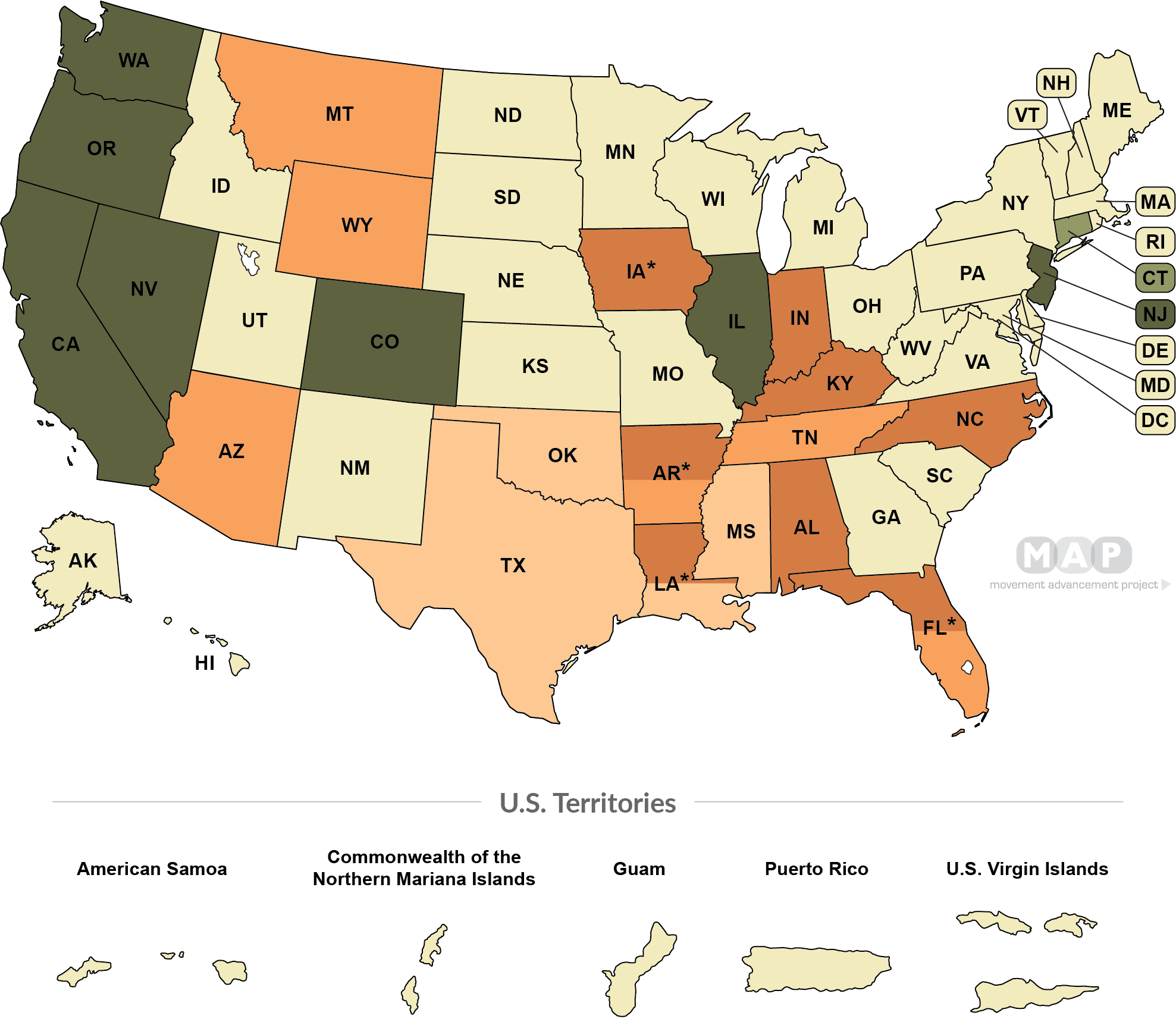LGBTQ-related curricular laws are important for LGBTQ students’ health, well-being, and academic success. This map shows multiple distinct policies related to LGBTQ inclusion in—or exclusion from—school curricula or standards. First, LGBTQ-inclusive curricular laws explicitly require the state’s curricular standards to include LGBTQ people and history, such as in subjects like history, civics, or social studies. Harmful, exclusionary laws include older-style censorship laws that restrict how schools can discuss "homosexuality" in specific subjects; parental notification laws, which require parents to be notified in advance of any LGBTQ-related curricula and allow parents to opt their children out of those classes (or require them to opt-in); and finally more recent “Don’t Say LGBTQ” laws that explicitly censor teachers and staff from discussing LGBTQ people or issues throughout all curricula. Click "Citations & More Information" beneath the map legend for more information about all these types of laws, and learn more about
the importance of inclusive curricular standards from GLSEN.

-
State law explicitly requires LGBTQ inclusion in state curricular standards
(7 states)
-
State law requires state education department to create LGBTQ-inclusive model curriculum, but does not require schools to use it
(1 state)
-
State has none of these LGBTQ-specific curricular laws
(26 states , 5 territories + D.C.)
-
State law restricts how schools can discuss "homosexuality" in specific curricula (e.g., sex education) (see note)
(4 states)
-
State law requires advance parental notification of any LGBTQ-related curricula and allows parents to opt their children out (or requires opt-in)
(7 states)
-
State law explicitly censors discussions of LGBTQ people or issues throughout all school curricula (i.e., “Don’t Say LGBTQ”)
(8 states)
*Notes:
--In the late 1980s, amidst the HIV/AIDS crisis, states began to enact censorship laws restricting how schools could discuss "homosexuality" in specific subjects like sex or health education. In 2021, these censorship efforts saw a resurgence--and a dramatic escalation--beginning with Florida's "Don't Say LGBTQ" law that explicitly banned any discussion of LGBTQ people or issues throughout all school subjects, curricula, learning materials, and more. Click "Citations & More Information" above for further details and sources about each and every state. --Arkansas and Florida have both a "Don't Say LGBTQ" law censoring discussions of LGBTQ people in schools and a parental notification law. The parental notification laws were enacted first in both states.--Louisiana has both an older-style law (enacted 1987) limiting discussion of homosexuality in specific subjects and a "Don't Say LGBTQ" law (enacted 2024) now censoring discussions of LGBTQ people throughout all subjects and settings. --In March 2024, the state of Florida settled a lawsuit that limited the scope of the state's "Don't Say LGBTQ" law to instruction only. This means that students can, for example, ask questions about LGBTQ people or issues and teachers can respond, that schools can have Gender-Sexuality Alliances (GSAs), and more. However, the ban still applies to classroom instruction, which is the focus of this map. --In December 2023, a federal judge temporarily blocked Iowa's "Don't Say LGBTQ" law. --Click "Citations & More Information" beneath the map legend, or the "Citations" tab above, for more information about these and all states.Often, laws requiring LGBTQ-inclusive curricular standards also require inclusive representation of other communities like people of color, people with disabilities, and religious minorities. Learn more about the importance of inclusive curricular standards from GLSEN.
Recommended citation:
Movement Advancement Project. "Equality Maps: LGBTQ Curricular Laws."
https://www.mapresearch.org/equality_maps/curricular_laws. Accessed [day of access].
Percent of LGBTQ Youth Covered by Laws
*Note: These percentages reflect estimates of the LGBTQ youth (ages 13-17) population living in the 50 states and the District of Columbia. Estimates of LGBTQ youth in the U.S. territories or under age 13 are not available, and so cannot be reflected here. Population estimates are from The Williams Institute.
25 % of LGBTQ youth (ages 13-17) live in states that require inclusion of LGBTQ people/history in school curricular standards
1 % of LGBTQ youth (ages 13-17) live in states that require the state education department to develop an LGBTQ-inclusive model curriculum, but do not require schools to use it
40 % of LGBTQ youth (ages 13-17) live in states with none of these LGBTQ-specific curricular laws
13 % of LGBTQ youth (ages 13-17) live in states that restrict how schools can discuss "homosexuality" in specific curricula (e.g., sex education) (see note beneath the map)
12 % of LGBTQ youth (ages 13-17) live in states that require parental notification of any LGBTQ-related curricula and allow parents to opt their children out (or require opt-in)
17 % of LGBTQ youth (ages 13-17) live in states that explicitly censor discussions of LGBTQ people or issues throughout all school curricula (i.e., “Don’t Say LGBTQ”)


